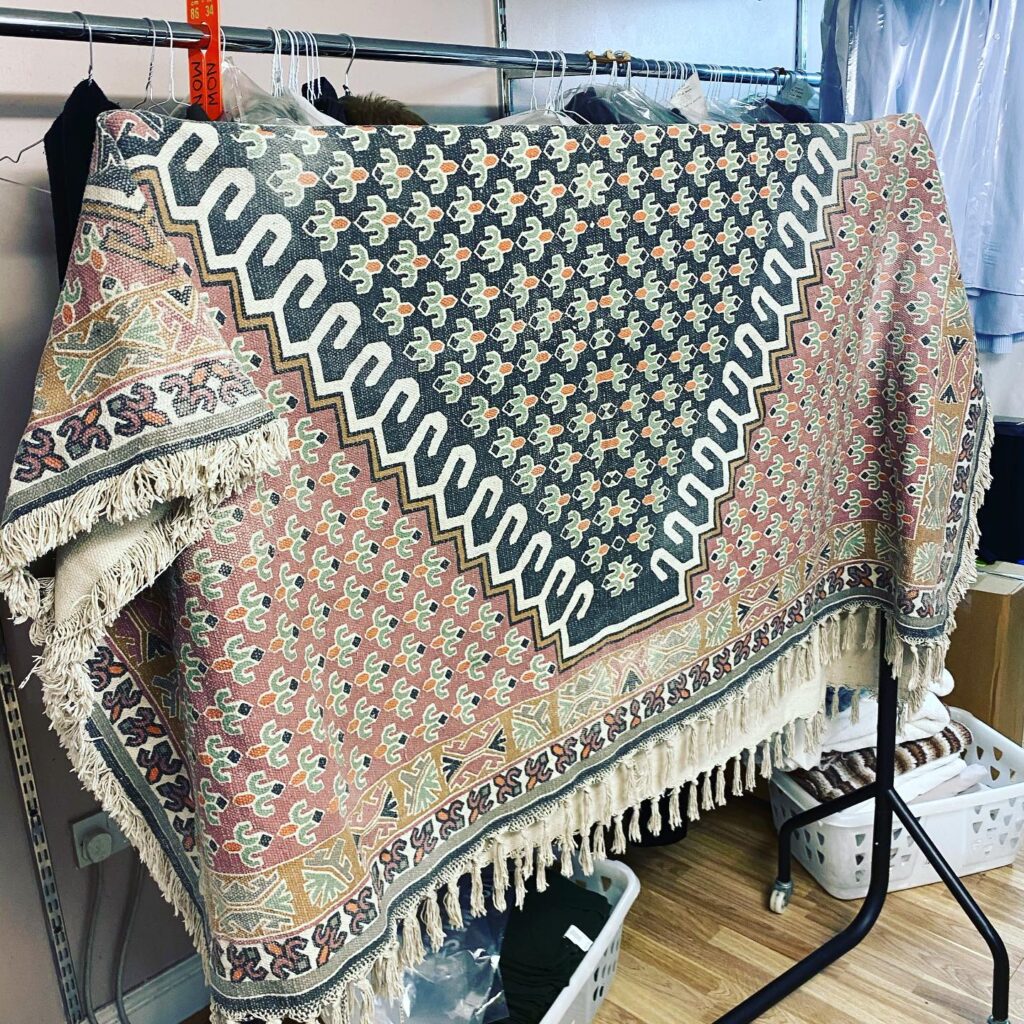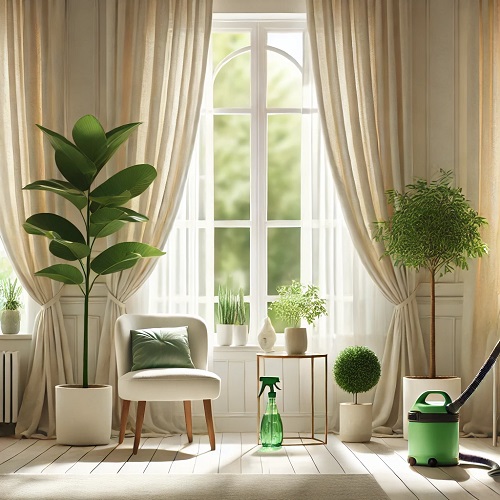Introduction: Unseen Pollutants Lurking in Your Curtains

Curtain cleaning is often overlooked when it comes to maintaining good indoor air quality. How often do you think about your curtains as silent collectors of dust, pollen, and other airborne pollutants? We tend to focus on vacuuming carpets and wiping down surfaces, but curtains quietly accumulate particles over time. These unseen pollutants can affect the air you breathe, especially for those with allergies or respiratory issues.
Curtains act like a filter, trapping dust and allergens from the air. Over time, this buildup can become a breeding ground for bacteria, mold, and even mites. As these particles become airborne again, they contribute to poor indoor air quality. This is why regular curtain cleaning is essential—not just for the look and feel of your home but for the air you and your family breathe.
By incorporating routine curtain cleaning, you can significantly reduce the number of pollutants in your living space, leading to fresher, healthier air.
Curtains: The Silent Air Filters in Your Home
Most people don’t realize that curtains work like passive air filters in their homes. They might add beauty to a room, but they also quietly gather airborne particles that affect indoor air quality.
How Curtains Trap Airborne Particles
Curtains act as a barrier between the outside world and your indoor space. Every time you open a window or door, you invite in dust, pollen, and even smoke particles. These tiny particles settle into the fabric of your curtains over time, often going unnoticed.
Key particles that curtains collect include:
- Dust: Accumulates from the air, furniture, and everyday activities.
- Pollen: Enters through windows and clings to curtain fibers.
- Smoke particles: Especially common in homes with smokers or those living in urban areas.
As these particles build up, they can eventually re-enter the air when disturbed by movement or drafts. This continuous cycle of particle collection and release can compromise the air quality in your home.
How Curtain Cleaning Eliminates Hidden Contaminants
Without regular curtain cleaning, these trapped pollutants will keep circulating in your living space, worsening allergies and respiratory issues. By cleaning your curtains regularly, you remove this buildup of contaminants, preventing them from polluting your home’s air.
Curtain cleaning doesn’t just enhance the appearance of your curtains—it also ensures your indoor air is fresher and healthier. Regular care will keep your home environment cleaner and safer for everyone living in it.
The Consequences of Neglecting Curtain Cleaning
Curtains often go unnoticed in our regular cleaning routines, but neglecting curtain cleaning can have serious consequences. Over time, curtains accumulate dust, pollen, and pollutants, which can impact the quality of the air you breathe.
Gradual Buildup of Pollutants
As your curtains quietly collect dust, pet dander, and pollen, these particles can stay trapped for months or even years. Every time your curtains move—whether from a breeze or daily activity—these pollutants get redistributed into the air, impacting the overall air quality in your home.
Health Effects from Dirty Curtains
Dirty curtains don’t just affect your home’s appearance; they can also have a significant impact on your health. Common health issues linked to neglected curtains include:
- Respiratory problems: Inhaling particles trapped in the fabric can lead to breathing difficulties, especially for people with asthma.
- Allergies: Dust and pollen trapped in the curtains can trigger sneezing, watery eyes, and other allergic reactions.
- Skin irritations: Continuous exposure to dust mites and other allergens may cause itching and discomfort.
Risk of Mold Growth in Humid Conditions
If your home has high humidity levels, neglecting curtain cleaning can lead to mold and mildew growth. Curtains in damp environments are particularly vulnerable, especially in kitchens and bathrooms. Mold not only damages the fabric but also releases spores that worsen air quality and can cause severe health problems.
Regular curtain cleaning helps avoid these issues, ensuring a cleaner, healthier living environment for your family.
How Curtain Fabrics Affect Indoor Air Quality
The type of fabric your curtains are made from plays a key role in how they impact indoor air quality. Some materials are more likely to trap dust and allergens, while others can be easier to maintain through regular curtain cleaning.

Different Fabric Types and Air Quality
Curtains come in a variety of fabrics, each with its own level of susceptibility to collecting airborne particles. Heavier, textured fabrics like velvet and brocade tend to trap more dust and pollen, while lighter fabrics like cotton or linen allow better air circulation and collect fewer pollutants. However, all curtain types need regular cleaning to prevent buildup over time.
Natural vs. Synthetic Materials
When comparing natural and synthetic fabrics, natural materials like cotton and linen are generally more breathable but may still attract dust. Synthetic materials like polyester can resist dust and allergens to some extent but may hold onto other pollutants such as chemicals or smoke particles.
Key differences include:
- Natural fabrics: Tend to be more breathable but can trap dust over time.
- Synthetic fabrics: Less likely to trap dust but may harbor other airborne particles.
Tailored Curtain Cleaning Methods
To maintain optimal air quality, it’s important to match the curtain cleaning method with the fabric type. Heavier fabrics may require professional dry cleaning, while lighter materials can often be machine-washed. Using the correct cleaning technique for your curtain type ensures you remove pollutants effectively and preserve the quality of the fabric, leading to cleaner air in your home.
How Curtain Cleaning Improves Air Quality
Regular curtain cleaning is essential to maintaining healthy indoor air quality by removing accumulated contaminants. Here’s how the process works:
Step-by-Step: How Curtain Cleaning Removes Contaminants
- Particle Removal: Over time, curtains collect dust, pollen, and even smoke particles. Cleaning helps remove these particles, preventing them from circulating in the air when disturbed.
- Allergen Reduction: Cleaning curtains reduces the amount of allergens like dust mites and pet dander that contribute to respiratory issues and allergies.
- Fresh Air Circulation: With the removal of trapped pollutants, the air in your home can flow more freely, improving overall air quality.
By regularly cleaning your curtains, you prevent the buildup of these harmful contaminants, ensuring cleaner air for your home.
The Role of Professional Cleaning in Removing Deeply Embedded Particles
While home cleaning methods such as vacuuming and machine washing are effective for surface-level contaminants, professional curtain cleaning services can reach deeply embedded particles that are difficult to remove. Professional services use specialized equipment to thoroughly clean curtains, eliminating dust, mold, and bacteria that have settled deep within the fabric.
Improved Indoor Air Circulation
Clean curtains contribute to better air circulation. By removing trapped pollutants, air can flow more easily through your home, creating a fresher and healthier environment. Regular curtain cleaning improves not only the look of your home but also the overall quality of the air you breathe, making it an essential part of household maintenance.
When Is the Right Time to Clean Your Curtains?

Knowing when to schedule curtain cleaning is key to maintaining good air quality in your home. While it’s easy to overlook them, curtains quietly gather dust, pollen, and other pollutants that can affect your breathing.
Signs Your Curtains Are Impacting Air Quality
It’s important to pay attention to warning signs that your curtains need cleaning:
- Dust buildup: If you notice dust collecting on your window sills or in the air, your curtains may be the culprit.
- Allergy symptoms: Increased sneezing, coughing, or watery eyes might indicate your curtains are full of allergens.
- Foul odors: Lingering smells can be a sign that your curtains have trapped pollutants, especially in homes with pets or smokers.
If you observe any of these signs, it’s time to consider a thorough curtain cleaning.
Seasonal Cleaning Schedules
A good rule of thumb is to clean your curtains at least twice a year, with adjustments based on your living conditions. Spring and autumn are ideal times for deep cleaning, as these seasons often bring pollen and other airborne allergens into your home.
Additional Factors to Consider
Several factors influence how often you should clean your curtains:
- Household size: More occupants create more dust and pollutants.
- Location: Homes near busy roads or industrial areas may require more frequent cleaning.
- Environmental pollution: Living in areas with high pollution levels can lead to faster buildup of particles.
By adjusting your curtain cleaning schedule based on these factors, you can ensure cleaner air year-round.
DIY Curtain Cleaning vs. Professional Services: What’s Best for Air Quality?
When it comes to improving air quality, both DIY and professional curtain cleaning have their advantages. However, understanding the pros and cons of each method can help you decide what’s best for your home’s air quality.
Pros and Cons of DIY Curtain Cleaning
Many homeowners choose DIY methods like vacuuming, spot cleaning, or machine washing their curtains. Here are the pros and cons:
Pros:
- Cost-effective: DIY methods are generally less expensive.
- Convenient: You can clean your curtains as often as you like.
- Immediate results: Light dust and dirt can be removed quickly.
Cons:
- Limited effectiveness: DIY cleaning may not reach deep into the fabric, leaving behind trapped allergens.
- Risk of damage: Some curtains require delicate handling, which can be tricky without the right tools.es provide optimal air quality improvements.
How Professional Curtain Cleaning Delivers Deeper Results
Professional curtain cleaning services use specialized equipment and techniques to remove deeply embedded particles like dust mites, mold, and bacteria. They ensure thorough cleaning without damaging delicate fabrics. This level of deep cleaning improves air quality by eliminating pollutants that DIY methods might miss.
When Professional Curtain Cleaning Becomes Necessary
There are certain situations where professional curtain cleaning is highly recommended:
- Heavily soiled curtains: If curtains haven’t been cleaned in a long time.
- Allergy sufferers: For those with severe allergies, professional cleaning can remove allergens more effectively.
- Mold or mildew issues: Humid environments can cause mold growth, which requires professional treatment to ensure safety.
In these cases, professional services provide optimal air quality improvements.
Eco-Friendly Curtain Cleaning Solutions for Cleaner Air

In today’s world, many are looking for ways to improve air quality without harming the environment. Choosing eco-friendly curtain cleaning solutions is a great way to keep your home clean while protecting the planet and your indoor air quality.
Green Cleaning Methods for a Healthier Home
Traditional cleaning methods often involve harsh chemicals that release harmful fumes into your home. Eco-friendly curtain cleaning avoids these toxins, using natural and biodegradable products instead. Methods such as steam cleaning and using organic detergents are great alternatives that effectively clean without compromising air quality.
Benefits of Sustainable Curtain Cleaning
Sustainable curtain cleaning offers a double benefit: it’s better for the environment and improves indoor air quality. By avoiding harsh chemicals, you reduce the risk of respiratory issues and allergies caused by chemical residues. At the same time, you’re contributing to a cleaner, safer environment for everyone by reducing pollution and waste.
Eco-friendly curtain cleaning is an excellent choice for cleaner air and a healthier home.
The Role of Eco-Friendly Detergents and Methods
Eco-friendly detergents are made from natural ingredients that break down easily and leave no harmful residues. These detergents help clean curtains thoroughly without releasing volatile organic compounds (VOCs), which can affect indoor air quality. Additionally, steam cleaning uses high temperatures to disinfect curtains, removing dust mites and bacteria without chemicals.
Some popular eco-friendly curtain cleaning methods include:
- Steam cleaning: Uses only water vapor to deep clean and sanitize curtains.
- Natural detergents: Plant-based, biodegradable solutions that remove dirt without toxic chemicals.
- Dry cleaning alternatives: Green dry cleaning processes that use non-toxic solvents.
Conclusion: Breathe Easier with Clean Curtains
Maintaining clean curtains is essential for a healthy living space. Regular curtain cleaning helps remove dust, pollen, and other pollutants that build up over time, improving your indoor air quality. Clean curtains contribute to better air circulation and reduce allergens, ensuring a fresher environment for you and your family.
Make curtain cleaning a priority by using professional services like those offered by 1StopWash. They provide reliable and effective cleaning solutions to keep your curtains fresh and your home healthy. Schedule your next cleaning with 1StopWash today for a cleaner, healthier home environment.

 0207 837 4997
0207 837 4997